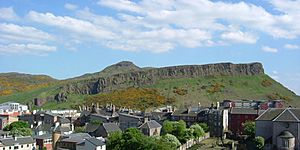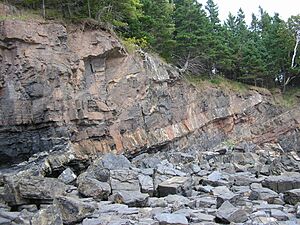Sill (geology) facts for kids

In geology, a sill is a type of rock formation. It looks like a flat, sheet-shaped layer of rock. Sills are formed when hot, melted rock, called magma, pushes its way between older layers of rock. These older rock layers can be sedimentary rock, lava from volcanoes, or metamorphic rock.
Sills are special because they do not cut across the existing rock layers. Instead, they push between them, staying parallel to the original layers. This is different from dykes, which cut through rock layers. Sills usually get their magma from dykes that come from deeper underground. The magma needs to find weak spots or cracks in the existing rocks to spread out. When the magma cools down and becomes solid, it forms a sill.
Contents
What is a Sill?
A sill is a flat, sheet-like body of igneous rock. It forms when magma pushes into cracks or spaces between layers of older rock. Imagine squeezing a thin layer of jam between two slices of bread; that's a bit like how a sill forms between rock layers.
How Sills Form
Sills are created deep inside the Earth. Hot, melted rock (magma) moves up from below. When this magma reaches existing rock layers, it can push its way between them. It flows along the flat surfaces where the rock layers meet. This happens because the magma finds the easiest path. It doesn't break through the layers, but rather spreads out between them.
The magma then cools down very slowly. As it cools, it turns into solid rock. This new rock layer, which is now a sill, lies parallel to the older rocks around it. The type of rock that forms a sill can vary. It depends on what kind of magma was involved.
Sills vs. Dykes
It's easy to confuse sills with dykes, but they are different.
- A sill is a flat sheet of rock that lies parallel to the existing rock layers. Think of it as a horizontal layer.
- A dyke is also a sheet of rock, but it cuts across the existing rock layers. Dykes are usually more vertical or at an angle.
Sills often get their magma from dykes. The dyke acts like a pipe bringing magma up. Then, the magma spreads out sideways to form a sill.
Where Can You Find Sills?
Sills can be found all over the world. They are often seen in areas where there has been a lot of volcanic activity in the past. Over long periods, the rocks above a sill can wear away. This process, called erosion, can expose the sill on the Earth's surface.
For example, the Salisbury Crags in Edinburgh, Scotland, are a famous example of an exposed sill. They were partly uncovered during the ice ages. Another example is the sill found in Horton Bluff, Nova Scotia, Canada. It formed during the Mid-Carboniferous period, millions of years ago.
Images for kids
See also
- Lámina (geología) para niños (In Spanish)




